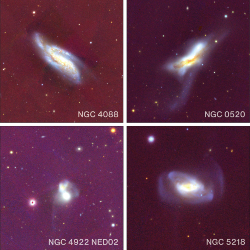
Over the past two decades, astronomers have concluded that most, if not all, galaxies host massive black holes in their centers—and the masses of a black hole and its host galaxy are correlated. But how are the two connected? Now, an undergraduate student who participated in University of Hawaiʻi at Mānoa Institute for Astronomy (IfA) Research Experiences for Undergraduates (REU) program may have revealed part of the answer.
In 2019, Rebecca Minsley worked for 10 weeks with mentor Andreea Petric, a Maunakea spectroscopic explorer deputy project scientist. Sifting meticulously through hundreds of images of galaxies, Minsley began to define a clearer picture of galaxy evolution. “A galaxy’s growth may be shaped by interactions with other galaxies, which impact the supermassive black hole (SMBH) that grows within the galaxy’s center,” Minsley explained.
The gas and dust between stars, called the interstellar medium (ISM), fuel both SMBH growth and the formation of new stars. “In the nearby universe, we find that the warm ISM of galaxies which host growing supermassive black holes at their centers differs from those that do not,” explained Petric. Warmer gas is less likely to collapse into new stars, so these results suggest that a growing central SMBH diminishes a galaxy’s ability to make new stars.
Peering deeply into galaxies

What might be responsible for heating the ISM? Starlight, especially from hot stars, is one possibility. But interactions between galaxies—when they collide or even just pass close to each other—can produce large-scale shock waves that compress less dense gas, making it more likely to form stars. Minsley studied the shapes of 630 galaxies using images from the Pan-STARRS survey. She classified the galaxies into mergers, early mergers and non-mergers. And then compared the shapes to the light output of the same galaxies at longer mid-infrared wavelengths, where she could study the properties of the ISM.
“When galaxies get close enough to each other, they go through a sort of galactic dance until they eventually coalesce into a single object. These interactions have well-documented signatures that allowed me to categorize our set of galaxies,” Minsley said. “This project gave me a greater appreciation for the complexity and entanglement of all the processes taking place inside galaxies and the research being done to deconstruct galactic systems is fascinating.”
Minsely and Petric’s research was published in The Astrophysical Journal.
IfA shapes astronomy leaders
Minsley is one of more than 130 students IfA has trained in its National Science Foundation funded REU program for nearly 20 years. Some of those students are now leaders in different fields of astronomy. Because of the unique opportunity to work in Hawaiʻi with world class facilities and scientists, IfA receives more than 500 applications each term. The focus of its program is to identify students who have potential to succeed in research, but may not have the opportunity and resources.
“With our mentors among the world leaders in their respective fields, our REU students are engaged in cutting edge research and Rebecca’s work is a prime example. We are very proud of our REU students, as almost all of them continued their studies in graduate school, and many of them have gained national recognition,” said IfA REU principal investigator Nader Haghighipour.
During the fall 2020 semester, Petric and UH Mānoa undergraduate Diana Castaneda will continue to investigate the ISM of galaxies hosting some of the most luminous growing SMBH in the nearby universe.

